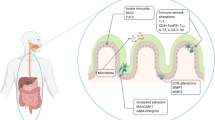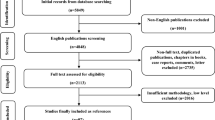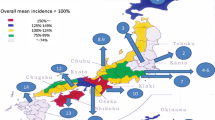Abstract
Background and aims
We analyzed the prevalence of concomitant intestinal stenosis in patients with fistulizing Crohn’s disease (CD), including the NOD2/CARD15 and IL23R genotype status.
Methods
Medical records of n = 1,110 patients with inflammatory bowel diseases were screened for patients with fistulizing and stricturing CD. Study inclusion required diagnosis of stenosis made within 6 months of diagnosing fistulas. CD-associated NOD2 and IL23R variants were genotyped. Similarly, we prospectively investigated 42 patients presenting with fistulizing CD.
Results
In the retrospective study (n = 333 CD patients), fistulas were found in 145 (43.5%) patients and stenoses in 223 (67.0%) patients. Concomitant stenosis was diagnosed in 125 patients with fistulas resulting in a positive predictive value (PPV) of 86.2% for fistulas predicting intestinal stenosis (p = 5.53 × 10−11; OR 5.74, 95% CI 3.22–10.50). In logistic regression analysis, presence of fistulas (OR 4.51; 95% CI 2.54–8.01, p = 2.68 × 10−7) and disease duration (OR 1.09; 95% CI 1.05–1.13; p = 3.19 × 10−6) were strongly associated with intestinal stenosis. NOD2 genotype information, but not IL23R status, increased the PPV for the correct diagnosis of stenosis (PPV = 89.9%). All homozygous carriers (100%) of NOD2 variants with fistulizing CD were diagnosed with stenosis; 1007fs homozygotes were found more often among patients with fistulas and stenoses than in patients without stenoses and fistulas (p = 0.00037). Similar results were found in the prospective analysis, in which 83.3% of the patients with fistulizing CD had concomitant stenosis.
Conclusion
Fistulizing CD is strongly associated with concomitant intestinal stenosis, particularly in homozygous carriers of NOD2 mutations.






Similar content being viewed by others
Abbreviations
- CARD:
-
Caspase-activation recruitment domain
- CD:
-
Crohn’s disease
- CI:
-
Confidence interval
- DC:
-
Dendritic cells
- fs:
-
Frameshift
- HD:
-
Human defensin
- IBD:
-
Inflammatory bowel disease
- IL:
-
Interleukin
- IL23R:
-
Interleukin 23 receptor (gene)
- MFP:
-
Multivariable fractional polynomials
- MRE:
-
MRI enteroclysma
- MRI:
-
Magnetic resonance imaging
- NOD:
-
Nucleotide-binding oligomerization domain
- NPV:
-
Negative predictive value
- OR:
-
Odds ratio
- PCR:
-
Polymerase chain reaction
- PPV:
-
Positive predictive value
- ROC:
-
Receiver-operating characteristic
- SNP:
-
Single nucleotide polymorphism
- TLR:
-
Toll-like receptor
- UC:
-
Ulcerative colitis
- wt:
-
Wild-type
References
Xavier RJ, Podolsky DK. Unravelling the pathogenesis of inflammatory bowel disease. Nature. 2007;448:427–34.
Podolsky DK. Inflammatory bowel disease. N Engl J Med. 2002;347:417–29.
Cho JH. The genetics and immunopathogenesis of inflammatory bowel disease. Nat Rev Immunol. 2008;8:458–66.
Crohn BB, Ginzburg L, Oppenheimer GD. Regional ileitis: A pathologic and clinical entity. JAMA. 1932;99:1323–9.
Penner A, Crohn B. Perianal fistulae as a complication of regional ileitis. Ann Surg. 1938;108:867–73.
Gasche C, Scholmerich J, Brynskov J, D’Haens G, Hanauer SB, Irvine EJ, et al. A simple classification of Crohn’s disease: report of the Working Party for the World Congresses of Gastroenterology, Vienna 1998. Inflamm Bowel Dis. 2000;6:8–15.
Silverberg MS, Satsangi J, Ahmad T, Arnott ID, Bernstein CN, Brant SR, et al. Toward an integrated clinical, molecular and serological classification of inflammatory bowel disease: Report of a Working Party of the 2005 Montreal World Congress of Gastroenterology. Can J Gastroenterol. 2005;19(Suppl A):5–36.
Cosnes J, Cattan S, Blain A, Beaugerie L, Carbonnel F, Parc R, et al. Long-term evolution of disease behavior of Crohn’s disease. Inflamm Bowel Dis. 2002;8:244–50.
Louis E, Collard A, Oger AF, Degroote E, Aboul Nasr El Yafi FA, Belaiche J. Behaviour of Crohn’s disease according to the Vienna classification: changing pattern over the course of the disease. Gut. 2001;49:777–82.
Brand S, Staudinger T, Schnitzler F, Pfennig S, Hofbauer K, Dambacher J, et al. The role of Toll-like receptor 4 Asp299Gly and Thr399Ile polymorphisms and CARD15/NOD2 mutations in the susceptibility and phenotype of Crohn’s disease. Inflamm Bowel Dis. 2005;11:645–52.
Seiderer J, Schnitzler F, Brand S, Staudinger T, Pfennig S, Herrmann K, et al. Homozygosity for the CARD15 frameshift mutation 1007 fs is predictive of early onset of Crohn’s disease with ileal stenosis, entero-enteral fistulas, and frequent need for surgical intervention with high risk of re-stenosis. Scand J Gastroenterol. 2006;41:1421–32.
Seiderer J, Brand S, Herrmann KA, Schnitzler F, Hatz R, Crispin A, et al. Predictive value of the CARD15 variant 1007fs for the diagnosis of intestinal stenoses and the need for surgery in Crohn’s disease in clinical practice: results of a prospective study. Inflamm Bowel Dis. 2006;12:1114–21.
Schnitzler F, Brand S, Staudinger T, Pfennig S, Hofbauer K, Seiderer J, et al. Eight novel CARD15 variants detected by DNA sequence analysis of the CARD15 gene in 111 patients with inflammatory bowel disease. Immunogenetics. 2006;58:99–106.
Barrett JC, Hansoul S, Nicolae DL, Cho JH, Duerr RH, Rioux JD, et al. Genome-wide association defines more than 30 distinct susceptibility loci for Crohn’s disease. Nat Genet. 2008;40:955–62.
Glas J, Seiderer J, Wetzke M, Konrad A, Torok HP, Schmechel S, et al. rs1004819 is the main disease-associated IL23R variant in German Crohn’s disease patients: combined analysis of IL23R, CARD15, and OCTN1/2 variants. PLoS ONE 2007;2:e819.
Herrmann KA, Michaely HJ, Seiderer J, Ochsenkuehn T, Reiser MF, Schoenberg SO. The “star-sign” in magnetic resonance enteroclysis: a characteristic finding of internal fistulae in Crohn’s disease. Scand J Gastroenterol. 2006;41:239–41.
Duerr RH, Taylor KD, Brant SR, Rioux JD, Silverberg MS, Daly MJ, et al. A genome-wide association study identifies IL23R as an inflammatory bowel disease gene. Science. 2006;314:1461–3.
Sauerbrei W, Royston P. Building multivariable prognostic and diagnostic models: transformation of the predictors by using fractional polynomials. J R Statist Soc (Ser A). 1999;162:71–94.
Sauerbrei W, Royston P. Corrigendum: building multivariable prognostic and diagnostic models: transformation of the predictors by using fractional polynomials. J R Statist Soc (Ser A). 2002;162:399–400.
Sauerbrei W, Meier-Hirmer C, Benner A, Royston P. Multivariable regression model building by using fractional polynomials: description of SAS, STATA and R programs. Comput Stat Data Anal. 2006;50:3464–85.
Hosmer DW, Lemeshow S. Applied logistic regression (Wiley Series in probability and statistics). New York: Wiley-Interscience; 2000.
Benjamini Y, Hochberg Y. Controlling the false discovery rate: a practical and powerful approach to multiple testing. J R Statist Soc Ser B (Methodol). 1995;57:289–300.
Hamilton LC. Regression with graphics. A second course in applied statistics. USA: Duxbury Press; 1992.
Brand S, Hofbauer K, Dambacher J, Schnitzler F, Staudinger T, Pfennig S, et al. Increased expression of the chemokine fractalkine in Crohn’s disease and association of the fractalkine receptor T280 M polymorphism with a fibrostenosing disease phenotype. Am J Gastroenterol. 2006;101:99–106.
Seiderer J, Dambacher J, Leistner D, Tillack C, Glas J, Niess JH. et al. Genotype-phenotype analysis of the CXCL16 p.Ala181Val polymorphism in inflammatory bowel disease. Clin Immunol. 2008;127:49–55.
Seiderer J, Elben I, Diegelmann J, Glas J, Stallhofer J, Tillack C. et al. Role of the novel Th17 cytokine IL-17F in inflammatory bowel disease (IBD): upregulated colonic IL-17F expression in active Crohn’s disease and analysis of the IL17F p.His161Arg polymorphism in IBD. Inflamm Bowel Dis. 2008;14:437–45.
Glas J, Konrad A, Schmechel S, Dambacher J, Seiderer J, Schroff F, et al. The ATG16L1 gene variants rs2241879 and rs2241880 (T300A) are strongly associated with susceptibility to Crohn’s disease in the German population. Am J Gastroenterol. 2008;103:682–91.
Seiderer J, Dambacher J, Kuhnlein B, Pfennig S, Konrad A, Torok HP, et al. The role of the selenoprotein S (SELS) gene −105G > A promoter polymorphism in inflammatory bowel disease and regulation of SELS gene expression in intestinal inflammation. Tissue Antigens. 2007;70:238–46.
Thalmaier D, Dambacher J, Seiderer J, Konrad A, Schachinger V, Pfennig S, et al. The +1059G/C polymorphism in the C-reactive protein (CRP) gene is associated with involvement of the terminal ileum and decreased serum CRP levels in patients with Crohn’s disease. Aliment Pharmacol Ther. 2006;24:1105–15.
Torok HP, Glas J, Tonenchi L, Lohse P, Muller-Myhsok B, Limbersky O, et al. Polymorphisms in the DLG5 and OCTN cation transporter genes in Crohn’s disease. Gut. 2005;54:1421–7.
Mirow L, Hauenschild L, Hildebrand P, Kleemann M, Keller R, Franke C, et al. Recurrence of Crohn’s disease after surgery–causes and risks. Zentralbl Chir. 2008;133:182–7.
Vermeire S, Van Assche G, Rutgeerts P. Perianal Crohn’s disease: classification and clinical evaluation. Dig Liver Dis. 2007;39:959–62.
Bataille F, Rohrmeier C, Bates R, Weber A, Rieder F, Brenmoehl J, et al. Evidence for a role of epithelial mesenchymal transition during pathogenesis of fistulae in Crohn’s disease. Inflamm Bowel Dis. 2008;14:1514–27.
Buhner S, Buning C, Genschel J, Kling K, Herrmann D, Dignass A, et al. Genetic basis for increased intestinal permeability in families with Crohn’s disease: role of CARD15 3020insC mutation? Gut. 2006;55:342–7.
Brand S, Beigel F, Olszak T, Zitzmann K, Eichhorst ST, Otte JM, et al. IL-22 is increased in active Crohn’s disease and promotes proinflammatory gene expression and intestinal epithelial cell migration. Am J Physiol Gastrointest Liver Physiol. 2006;290:G827–38.
Schmechel S, Konrad A, Diegelmann J, Glas J, Wetzke M, Paschos E, et al. Linking genetic susceptibility to Crohn’s disease with Th17 cell function: IL-22 serum levels are increased in Crohn’s disease and correlate with disease activity and IL23R genotype status. Inflamm Bowel Dis. 2008;14:204–12.
Dambacher J, Beigel F, Zitzmann K, de Toni E, Goke B, Diepolder HM, et al. The role of the novel Th17 cytokine IL-26 in intestinal inflammation. Gut. 2009;58:1207–17.
Brand S, Olszak T, Beigel F, Diebold J, Otte JM, Eichhorst ST, et al. Cell differentiation dependent expressed CCR6 mediates ERK-1/2, SAPK/JNK, and Akt signaling resulting in proliferation and migration of colorectal cancer cells. J Cell Biochem. 2006;97:709–23.
Brand S. Crohn’s disease: Th1, Th17 or both? The change of a paradigm: new immunological and genetic insights implicate Th17 cells in the pathogenesis of Crohn’s disease. Gut. 2009;58:1152–67.
Acknowledgments
This manuscript contains parts of the unpublished degree thesis of J. Wagner. S. Brand was supported by grants from Deutsche Forschungsgemeinschaft (DFG; BR 1912/5-1), the Else Kröner-Fresenius-Stiftung (Else Kröner Fresenius Memorial Stipendium 2005; P50/05/EKMS05/62), the Ludwig-Demling Grant 2007 from DCCV e.V. and by grants from the Ludwig-Maximilians-University Munich (Excellence Initiative, Investment Funds 2008 and FöFoLe program). M. Jürgens and T. Ochsenkühn were supported by a grant from Centocor, Inc. J. Seiderer was supported by grants from the Ludwig-Maximilians-University (FöFoLe 422), Robert-Bosch-Stiftung and Else Kröner-Fresenius-Stiftung (Else Kröner-Fresenius Memorial Grant 2008; P81/08//EKMS08/01).
Conflict of interest statement
None of the authors and co-authors have a conflict of interest related to this manuscript.
Author information
Authors and Affiliations
Corresponding author
Additional information
M. Jürgens and S. Brand contributed equally to this work.
Electronic supplementary material
Below is the link to the electronic supplementary material.
Rights and permissions
About this article
Cite this article
Jürgens, M., Brand, S., Laubender, R.P. et al. The presence of fistulas and NOD2 homozygosity strongly predict intestinal stenosis in Crohn’s disease independent of the IL23R genotype. J Gastroenterol 45, 721–731 (2010). https://doi.org/10.1007/s00535-010-0231-7
Received:
Accepted:
Published:
Issue Date:
DOI: https://doi.org/10.1007/s00535-010-0231-7




